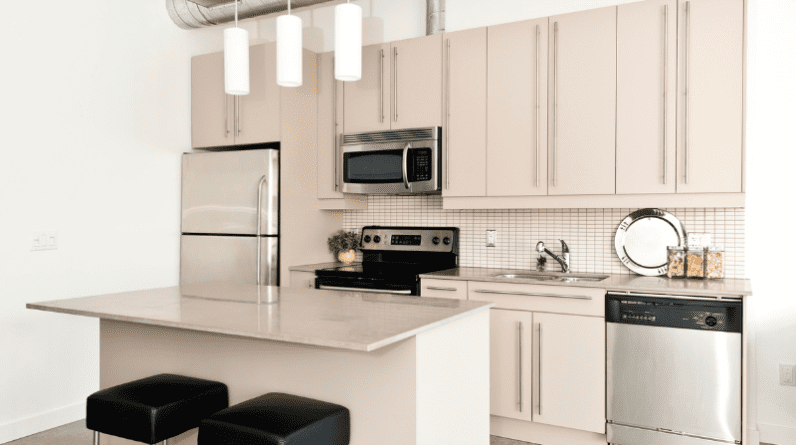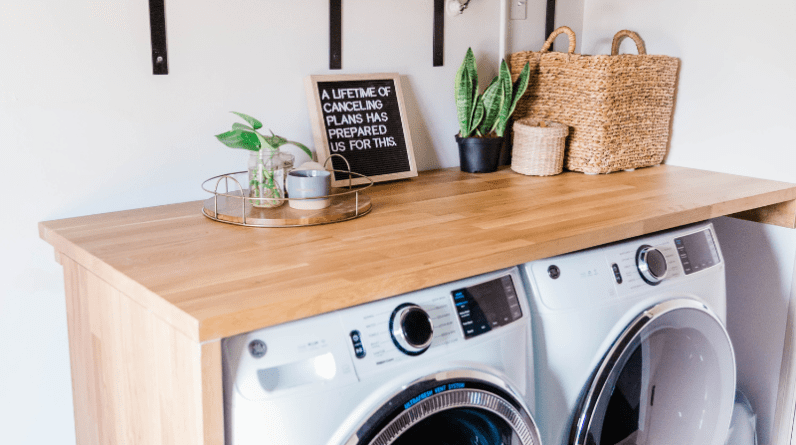
I. Introduction
Converting a garage into a modern kitchen or dining area has become a captivating trend in recent years, as homeowners seek to maximize their living spaces and add value to their properties. Gone are the days when garages were solely used to store cars and clutter. Today, they present an exciting opportunity to transform underutilized areas into stylish and functional extensions of the home.
In this comprehensive guide, we will delve into the world of garage conversions, exploring the numerous benefits of creating a modern kitchen or dining space from this versatile area. Whether you’re looking to expand your existing kitchen, create a new dining area, or simply reimagine the potential of your garage, this article will provide you with valuable insights, practical tips, and creative ideas to help you embark on this exciting journey.
Why Convert Your Garage?
The decision to convert a garage into a modern kitchen or dining area is not only driven by the desire for additional space but also by the prospect of embracing contemporary living. The kitchen has evolved into more than just a place to cook; it has become a focal point for socializing and entertaining. Similarly, dining areas have transformed into cozy and welcoming spaces that bring family and friends together.
By repurposing your garage, you not only gain a functional extension to your living space but also have the opportunity to design a kitchen or dining area that reflects your unique style and meets your specific needs. Whether you’re an avid home chef, a frequent host of gatherings, or simply seeking a comfortable space to share meals with loved ones, converting your garage offers limitless possibilities to tailor the area to your lifestyle.
The Structure of the Article
Throughout this guide, we will take a step-by-step approach to help you navigate the conversion process smoothly. We’ll begin by assessing the feasibility of the project, considering important factors such as local regulations, structural modifications, budgeting, and timeline planning. With a solid foundation, we’ll then delve into the exciting design phase, exploring various layout options, contemporary design elements, and energy-efficient choices for your modern kitchen or dining area.
Recognizing that the garage door is a crucial element in the transformation, we will discuss different options for converting or replacing it to seamlessly integrate the new space with the rest of your home. We’ll also focus on essential aspects like insulation, climate control, electrical and plumbing considerations, and the finishing touches that add personality and character to your new space.
Additionally, we’ll address safety and security concerns, providing insights into safeguarding your transformed area. Throughout the article, we’ll emphasize the importance of hiring professionals when needed and offer guidance on managing the project effectively.
To inspire your creativity and illustrate the potential of garage conversions, we’ll showcase real-life case studies and examples of successful transformations. By the end of this guide, you’ll be equipped with the knowledge and inspiration needed to embark on your garage conversion journey confidently.
So, without further ado, let’s dive into the world of converting your garage into a modern kitchen or dining area, and unlock the hidden potential within your home.
Assessing the Feasibility
Before embarking on the exciting journey of converting your garage into a modern kitchen or dining area, it’s essential to assess the feasibility of the project. This stage involves evaluating various factors to ensure a smooth and successful transformation. Let’s explore the key steps involved in assessing the feasibility:
A. Checking Local Regulations and Permits
The first step in any garage conversion project is to familiarize yourself with local regulations and obtain the necessary permits. Building codes and zoning laws can vary significantly from one area to another, and it’s crucial to understand what is allowed and what restrictions may apply. Common regulations that might affect your conversion include:
- Zoning restrictions: Some areas may have zoning laws that dictate the type of structures allowed on residential properties.
- Building codes: Building codes outline the minimum standards for safety and construction in your area. Compliance with these codes is essential for a legal and safe conversion.
- Permits: Depending on the scope of your project, you may need permits for construction, electrical work, plumbing, and more. Failure to obtain the appropriate permits can result in fines or even having to undo the work.
Consult with your local building department or a professional contractor to ensure you have a clear understanding of the regulations and permits required before proceeding.
B. Evaluating Structural Integrity and Necessary Modifications
Once you’ve confirmed that your garage conversion aligns with local regulations, the next step is to assess the structural integrity of the existing space. Garages are typically designed to support the weight of vehicles and not as living spaces, so some modifications may be necessary. Key considerations include:
- Foundation and Flooring: Check for any cracks or damage in the foundation and ensure it is level. Additionally, consider the garage’s flooring and whether it needs to be reinforced or replaced to support the new use.
- Walls and Roofing: Inspect the walls and roofing for signs of leaks, water damage, or structural issues. Any problems should be addressed before proceeding with the conversion.
- Ventilation and Insulation: Evaluate the existing ventilation system and insulation. Proper insulation is crucial for maintaining a comfortable environment in the new kitchen or dining area.
C. Creating a Budget and Timeline
Converting a garage into a modern kitchen or dining area can be a significant investment, so it’s essential to establish a realistic budget from the outset. Consider the costs of materials, labor, permits, and any additional expenses that might arise during the process. Obtain quotes from contractors or professionals to get a better understanding of the costs involved.
Furthermore, create a timeline for the project, accounting for the time needed to secure permits, complete construction, and any potential delays. Having a well-planned timeline will help keep the project on track and ensure a smooth transition from garage to modern kitchen or dining area.
By carefully assessing the feasibility of your garage conversion project, you’ll lay the groundwork for a successful transformation. It’s crucial to be aware of regulations, evaluate structural integrity, and set a realistic budget and timeline before moving on to the design and construction phase. With these preliminary steps completed, you can confidently move forward and bring your vision of a modern kitchen or dining area to life.
With the feasibility of your garage conversion project confirmed, it’s time to dive into the exciting phase of designing your modern kitchen or dining area. This stage allows you to unleash your creativity and envision the perfect space that suits your lifestyle and preferences. Here are the key steps to consider during the design process:
A. Setting Clear Goals and Objectives
Before delving into specific design elements, it’s essential to establish clear goals and objectives for your modern kitchen or dining area. Ask yourself the following questions:
- How will the space be used? Will it primarily serve as a kitchen, a dining area, or a combination of both?
- What are the essential features and functionalities you want to incorporate? For instance, do you need ample storage space, a kitchen island, or a large dining table?
- What style and atmosphere do you want to achieve? Consider elements like color schemes, materials, and decor that align with your vision.
By having a clear understanding of your goals, you’ll be able to make informed decisions throughout the design process and create a space that truly reflects your vision.
B. Choosing the Optimal Layout and Floor Plan
Optimizing the layout and floor plan is crucial for maximizing the functionality and flow of your modern kitchen or dining area. Depending on the size and shape of your garage, you may have various layout options to explore:
- Open Concept: Embrace the popular trend of an open concept design, which combines the kitchen and dining area into one cohesive space. This layout promotes a sense of openness and encourages social interaction.
- Kitchen-Centric: If you plan to use the space primarily as a kitchen, prioritize kitchen functionality with adequate counter space, storage, and easy access to essential appliances.
- Dining-Focused: For those focusing on creating a welcoming dining area, center the design around a stylish dining table and comfortable seating arrangements.
- L-Shaped or U-Shaped: Utilize L-shaped or U-shaped layouts to maximize the available space and create an efficient work triangle between the sink, stove, and refrigerator in the kitchen.
C. Selecting Modern and Functional Design Elements
When transforming your garage into a modern kitchen or dining area, your design choices play a pivotal role in achieving the desired aesthetics and functionality. Consider the following design elements:
- Cabinetry and Storage Solutions: Choose sleek and contemporary cabinetry that complements your overall design. Maximize storage with smart solutions like pull-out shelves, deep drawers, and corner units.
- Countertops and Kitchen Islands: Opt for durable and visually appealing countertops that can withstand the rigors of daily use. A kitchen island can serve as a multifunctional centerpiece, providing extra storage, workspace, and a gathering spot.
- Flooring and Lighting Options: Select flooring materials that are easy to clean and maintain, such as tiles or hardwood. Adequate lighting is essential for both safety and ambiance; include a mix of task lighting, ambient lighting, and decorative fixtures.
- Energy-Efficient Appliances: Choose energy-efficient appliances to reduce utility costs and environmental impact. Look for appliances with high energy star ratings.
By thoughtfully combining these design elements, you’ll create a modern kitchen or dining area that perfectly suits your lifestyle and reflects your personal taste.
In the next section, we’ll explore different options for converting the garage door and seamlessly integrating the new space with the rest of your home.
IV. Garage Door Conversion Options
Converting the garage door is a pivotal step in transforming your garage into a modern kitchen or dining area. This process involves replacing the garage door with a more suitable alternative that complements the new function of the space. Here are some popular garage door conversion options to consider:
A. Replacing the Garage Door with a Permanent Wall
One of the most straightforward approaches to converting the garage door is by replacing it with a permanent wall. This option provides a seamless transition between the interior and exterior, making the space feel like a natural extension of your home. The new wall can be designed to match the existing exterior, ensuring a cohesive and aesthetically pleasing appearance.
Replacing the garage door with a permanent wall also improves insulation and noise reduction, making your modern kitchen or dining area more comfortable and private.
B. Installing Large Glass Sliding Doors
For those seeking a more contemporary and light-filled space, installing large glass sliding doors is an excellent choice. These doors can be fitted in place of the garage door opening, creating a visually stunning and functional connection to the outdoors.
Glass sliding doors allow an abundance of natural light to flood the interior, creating an airy and inviting atmosphere. When opened, they provide easy access to outdoor areas, making it perfect for entertaining and indoor-outdoor living.
C. Transforming the Garage Door into a Stylish Glass Wall
Another innovative option is to convert the garage door into a stylish glass wall. This involves removing the actual garage door and replacing it with a series of glass panels. The glass wall not only adds a modern touch but also serves as a transparent partition, seamlessly integrating the interior space with the exterior.
This design choice allows for uninterrupted views of the surrounding environment, making it ideal for properties with beautiful landscapes or outdoor features.
Factors to Consider
When considering which garage door conversion option to pursue, keep the following factors in mind:
- Aesthetics: Choose a conversion option that complements the architectural style of your home and aligns with the overall design of your modern kitchen or dining area.
- Functionality: Consider how the new opening will affect the flow and functionality of the space, as well as how it enhances natural light and ventilation.
- Budget: Each conversion option comes with varying costs, so assess your budget and select the option that best fits your financial considerations.
- Climate: Take into account the climate of your location, as glass doors and walls may have different insulation properties compared to solid walls.
Professional Assistance
Garage door conversion is a task that requires expertise, and it’s essential to seek the help of qualified professionals for a safe and successful installation. Consulting with architects, contractors, or interior designers will ensure that the conversion is executed with precision and adherence to building codes.
By carefully considering the various garage door conversion options and seeking professional guidance, you’ll enhance the appeal and functionality of your modern kitchen or dining area, while seamlessly integrating it with the rest of your home. In the subsequent sections, we’ll explore essential considerations for insulation and climate control, electrical and plumbing aspects, and the finishing touches that will bring your vision to life.
V. Insulation and Climate Control
Insulation and climate control are crucial aspects of converting your garage into a modern kitchen or dining area. Proper insulation ensures that the space remains comfortable throughout the year, while efficient climate control systems help maintain a pleasant environment regardless of external weather conditions. Let’s delve into the key considerations for insulation and climate control:
A. Ensuring Proper Insulation for Year-Round Comfort
Garages are typically not insulated to the same standards as living spaces. Therefore, enhancing insulation is essential to prevent heat loss during colder months and keep the area cool during warmer seasons. Here are some insulation options to consider:
- Wall Insulation: Insulating the walls with materials like fiberglass or foam board can significantly improve the thermal performance of the space. For existing walls, blown-in insulation might be an option.
- Ceiling Insulation: Adequately insulating the ceiling helps prevent heat from escaping through the roof. Fiberglass or cellulose insulation can be used, and you may consider adding a radiant barrier for extra heat reflectance.
- Weatherstripping: Seal any gaps around doors and windows with weatherstripping to minimize air leakage and maintain a consistent indoor temperature.
- Insulated Garage Door: If you opt for a permanent wall or glass doors, consider investing in an insulated garage door to further improve energy efficiency.
Proper insulation not only enhances comfort but also reduces energy consumption, leading to potential savings on utility bills.
B. Incorporating Efficient Heating and Cooling Systems
Maintaining a comfortable temperature in your modern kitchen or dining area requires efficient heating and cooling systems. Depending on your location and climate, you might need both heating and cooling options to adapt to changing weather conditions:
- Heating Options: Consider installing radiant floor heating, baseboard heaters, or a central heating system to keep the space warm during colder months.
- Cooling Options: Air conditioning is essential for staying cool during hot summers. Ductless mini-split systems or central air conditioning can efficiently cool the area without taking up valuable space.
- Zoning: If your garage conversion includes both a kitchen and dining area, consider zoning the heating and cooling systems to control temperature independently in each section.
C. Utilizing Natural Light and Ventilation
Maximizing natural light and ventilation is beneficial for the ambiance and energy efficiency of your modern kitchen or dining area. If you’ve opted for glass sliding doors or a glass wall, you’re already allowing ample natural light to enter. Here are additional considerations for harnessing natural elements:
- Skylights: Incorporating skylights in the roof can flood the space with natural light during the day and provide a sense of openness.
- Window Placement: If possible, add windows strategically to capture cross ventilation, facilitating air circulation and reducing reliance on mechanical cooling systems.
- Window Treatments: Consider light and breathable window treatments that allow you to control sunlight while preserving privacy.
- Ventilation Fans: Install exhaust fans to improve air circulation and eliminate cooking odors in the kitchen area.
By effectively managing insulation and climate control, you’ll create a comfortable and pleasant environment for year-round use in your modern kitchen or dining area. The following section will focus on essential electrical and plumbing considerations as you finalize the transformation.
VI. Electrical and Plumbing Considerations
Proper electrical and plumbing planning is vital when converting your garage into a modern kitchen or dining area. These considerations ensure the functionality and safety of the space, allowing you to enjoy all the modern amenities and conveniences you desire. Here are the key aspects to address during the electrical and plumbing phase:
A. Hiring Professional Electricians and Plumbers
Electrical and plumbing work requires the expertise of licensed professionals to ensure compliance with safety standards and building codes. Hiring qualified electricians and plumbers is crucial to guarantee a smooth and safe installation process.
Before proceeding, consult with these professionals to discuss your specific requirements and any potential challenges they may encounter during the conversion.
B. Planning the Electrical Layout for Lighting and Appliances
Designing a well-thought-out electrical layout is essential to accommodate your lighting needs, kitchen appliances, and other electrical fixtures. Consider the following:
- Lighting: Decide on the type and placement of lighting fixtures to achieve optimal illumination in your kitchen and dining area. Include task lighting above work areas, ambient lighting for overall illumination, and decorative fixtures for aesthetic appeal.
- Kitchen Appliances: Ensure that the electrical system can handle the power demands of your kitchen appliances, such as ovens, cooktops, refrigerators, and dishwashers. Plan for dedicated circuits to avoid overloading and tripping circuit breakers.
- Outlets: Strategically place electrical outlets for convenient access to power sources. Plan for enough outlets along the countertop, dining area, and any other areas where electrical devices may be used.
- Smart Home Integration: If you’re interested in incorporating smart home technology, discuss the installation of smart switches, outlets, and other devices with your electrician.
C. Installing Plumbing for Sinks, Dishwashers, etc.
If your garage conversion includes a kitchen, proper plumbing is essential to accommodate sinks, dishwashers, and potentially other appliances that require water supply and drainage. Consider the following plumbing considerations:
- Sink Placement: Determine the ideal location for your kitchen sink, considering convenience, accessibility to plumbing lines, and proximity to the dining area.
- Dishwasher Installation: Plan for the installation of a dishwasher if you desire one in your kitchen. Ensure there is a dedicated water supply and drainage line for the dishwasher.
- Plumbing Fixtures: Choose high-quality plumbing fixtures that match the style of your modern kitchen or dining area. Consider low-flow faucets and fixtures to conserve water.
- Drainage System: Ensure that the plumbing system efficiently carries wastewater away from the sink and dishwasher, connecting it to the main sewer or septic system.
D. Gas Lines (If Applicable)
If your kitchen will include gas-powered appliances like a stove or oven, consult with a professional to determine the feasibility of extending gas lines to the kitchen area. Gas installations should always be carried out by qualified technicians.
Proper electrical and plumbing planning ensures that your modern kitchen or dining area is equipped with the necessary utilities and amenities for smooth daily operations. Hiring licensed professionals for these tasks will give you peace of mind and guarantee a safe and functional space.
In the next section, we’ll explore the finishing touches and aesthetics that will bring personality and charm to your converted garage space.
VII. Finishing Touches and Aesthetics
With the electrical and plumbing considerations in place, it’s time to add the finishing touches to your modern kitchen or dining area. These elements will enhance the aesthetics, functionality, and ambiance of the space, making it a welcoming and stylish part of your home. Here are some essential finishing touches to consider:
A. Choosing the Right Color Palette and Interior Decor
Selecting an appropriate color palette is vital in setting the tone for your modern kitchen or dining area. Opt for colors that align with your desired atmosphere and complement the overall style of your home. Popular choices include neutral tones like whites, grays, and earthy hues, which create a clean and contemporary backdrop.
Incorporate pops of color through decor elements like curtains, rugs, or accent pieces to add vibrancy and personality to the space. Consider your personal taste and the mood you want to evoke when making these decorative choices.
B. Incorporating Smart Home Technology
Integrating smart home technology can elevate the functionality and convenience of your modern kitchen or dining area. Explore options such as:
- Smart Lighting: Install smart light bulbs or switches that can be controlled through your smartphone or voice commands. You can customize lighting scenes for different occasions.
- Smart Appliances: Invest in energy-efficient smart appliances that offer advanced features and remote control capabilities.
- Smart Thermostat: Implement a smart thermostat to efficiently manage heating and cooling, reducing energy consumption.
- Voice Assistants: Consider adding a voice-controlled assistant, like Amazon Alexa or Google Assistant, to perform tasks hands-free.
C. Adding Greenery and Natural Elements
Infuse your modern kitchen or dining area with a touch of nature by adding indoor plants or a herb garden. Greenery not only adds aesthetic appeal but also contributes to improved air quality and a sense of tranquility. Choose low-maintenance plants that thrive in indoor environments.
Additionally, consider incorporating natural elements in your decor, such as wooden furniture, stone accents, or natural fiber rugs. These elements create a warm and inviting ambiance in your converted space.
D. Personalizing with Art and Decorative Items
Personalize your modern kitchen or dining area with art and decorative items that resonate with your taste and interests. Hang artwork or photographs on the walls to add character to the space. Display decorative plates or unique kitchen utensils to create focal points.
Moreover, consider adding a stylish rug to anchor the dining area or placing decorative cushions on seating to enhance comfort and style.
E. Ensuring Ample Storage Solutions
Storage is essential to keep your modern kitchen or dining area organized and clutter-free. Incorporate creative storage solutions such as built-in cabinets, shelves, and kitchen islands with storage compartments. Utilize vertical space effectively to make the most of the available room.
Efficient storage not only keeps the area tidy but also ensures that essential items are easily accessible.
By carefully curating these finishing touches and aesthetics, you’ll transform your garage into a modern kitchen or dining area that reflects your personality and complements your lifestyle. The integration of smart home technology, natural elements, and thoughtful decor will add the perfect final touches to your converted space.
In the next section, we’ll focus on safety and security measures to ensure the well-being of your new kitchen or dining area and your home as a whole.
VIII. Safety and Security Measures
As you convert your garage into a modern kitchen or dining area, ensuring the safety and security of the space becomes paramount. Implementing appropriate safety measures will provide peace of mind and protect your home and loved ones. Here are essential safety and security considerations to prioritize:
A. Installing Smoke Detectors and Fire Extinguishers
Fire safety should be a top priority in any living space, including your modern kitchen. Install smoke detectors in strategic locations throughout the area, including the kitchen and dining sections. These devices will promptly alert you in case of smoke or fire, giving you valuable time to respond.
Additionally, keep a fire extinguisher within easy reach, preferably near the kitchen area. Regularly inspect and maintain both the smoke detectors and fire extinguisher to ensure their functionality.
B. Enhancing Security with Alarms and Surveillance Systems
Integrate a comprehensive security system to safeguard your converted space and the rest of your home. Consider installing:
- Burglar Alarms: A reliable burglar alarm system with sensors on doors and windows will deter potential intruders and alert you in case of unauthorized entry attempts.
- Surveillance Cameras: Strategically position security cameras to monitor the exterior and interior of your home, providing an additional layer of protection and allowing remote monitoring.
- Smart Doorbell: A smart doorbell with a built-in camera allows you to see and communicate with visitors at your front door, enhancing overall security.
- Motion-Activated Lighting: Install motion-activated lighting around the perimeter of your home to discourage intruders and improve visibility at night.
C. Childproofing and Safety Measures
If your modern kitchen or dining area will be frequented by children, prioritize childproofing measures to prevent accidents and ensure a safe environment. Consider installing child safety locks on cabinets and drawers containing potentially harmful items, like cleaning supplies or sharp objects.
If your dining area features a table with sharp corners, consider using edge guards to minimize the risk of injury. Keep electrical outlets covered and secure cords to prevent tripping hazards.
D. Adhering to Electrical Safety Practices
Electrical safety is critical in any living space. Ensure that electrical outlets are tamper-resistant, especially if there are young children around. Avoid overloading outlets with multiple devices and use extension cords sparingly.
Regularly check for frayed wires or damaged electrical components, and address any issues promptly. Encourage responsible use of electrical appliances and teach family members about basic electrical safety practices.
E. First Aid Kit and Emergency Preparedness
Have a well-stocked first aid kit easily accessible in your modern kitchen or dining area. This kit should include essential medical supplies to address minor injuries. Familiarize yourself and your family with the location of the kit and how to use its contents.
Additionally, create an emergency preparedness plan for your home. Educate family members on evacuation procedures in case of emergencies, such as fires or natural disasters. Have a designated meeting point outside the home where everyone can gather in case of evacuation.
By implementing these safety and security measures, you’ll create a secure environment for your modern kitchen or dining area, ensuring the well-being of your family and enhancing the overall safety of your home.
In the concluding section, we’ll summarize the benefits of converting your garage into a modern kitchen or dining area and encourage readers to take action in transforming their spaces.
IX. Taking Action: Converting Your Garage into a Modern Kitchen or Dining Area
Now that you have explored the various aspects of converting your garage into a modern kitchen or dining area, it’s time to take action and turn your vision into reality. This concluding section emphasizes the benefits of this transformation and provides guidance on moving forward with your project.
A. Recapitulating the Benefits
Converting your garage into a modern kitchen or dining area offers a multitude of benefits that enhance your living experience:
- Increased Living Space: By repurposing your garage, you gain valuable square footage, allowing you to expand your living and entertaining areas.
- Enhanced Functionality: A modern kitchen or dining area tailored to your needs enhances daily living and creates a welcoming space for gatherings.
- Added Home Value: A well-executed garage conversion can increase your home’s overall value, making it an attractive investment for the future.
- Contemporary Living: Embracing modern design elements and smart home technology elevates your lifestyle and keeps your home up-to-date with current trends.
- Personal Expression: Converting the garage into a customized space lets you express your style and preferences, creating a unique area that aligns with your personality.
B. Taking the First Steps
To embark on your garage conversion project, follow these steps:
- Planning and Research: Clearly define your goals and objectives for the new space. Research local regulations and obtain necessary permits before proceeding.
- Consulting Professionals: Engage with architects, contractors, electricians, and plumbers to assess feasibility, obtain expert advice, and ensure safe execution.
- Design and Layout: Plan the layout and design of your modern kitchen or dining area, considering functionality, aesthetics, and optimal use of available space.
- Selecting Materials and Appliances: Choose quality materials, energy-efficient appliances, and smart home technology to complement your design.
- Project Management: Create a realistic budget and timeline, and manage the project efficiently to stay on track.
- Safety and Security: Prioritize safety measures, including smoke detectors, fire extinguishers, security systems, and childproofing.
- Finishing Touches: Personalize your space with decor, greenery, and smart home technology to create a welcoming and stylish environment.
C. Seeking Professional Assistance
Converting your garage into a modern kitchen or dining area is a significant undertaking that involves various aspects, from design to construction and safety. Seeking professional assistance ensures that the project is executed with precision, adheres to building codes, and achieves your desired vision.
D. Embrace the Transformation
Converting your garage into a modern kitchen or dining area offers an exciting opportunity to reimagine your home’s potential and create a space tailored to your lifestyle. By embracing the transformation, you’ll unlock the hidden value within your property and enjoy a functional and stylish extension of your living space.
Remember, thoughtful planning, professional guidance, and attention to detail are the keys to a successful garage conversion. So, take action now, and transform your garage into a modern kitchen or dining area that enriches your daily living and becomes a source of joy for years to come.
In this concluding section, we summarize the benefits of converting the garage and offer guidance on how to proceed with the project. If you need any further assistance or have more questions, feel free to ask!
X. Case Studies and Inspirations
To inspire your garage conversion project further, let’s explore some real-life case studies and examples of successful transformations. These success stories highlight the creativity, versatility, and potential of converting a garage into a modern kitchen or dining area. By drawing inspiration from these examples, you can gain valuable insights and ideas for your own transformation.
Case Study 1: The Modern Chef’s Haven
In this case study, a passionate home chef converted their underutilized garage into a dream kitchen. They opted for an open-concept layout, seamlessly blending the kitchen and dining areas. The kitchen featured high-end stainless steel appliances, a large central island with ample storage, and a custom-built pantry. Chic pendant lights and under-cabinet LED strips added an elegant touch to the space.
To maximize natural light, the homeowner installed a large glass sliding door, leading to a cozy outdoor patio for al fresco dining. This transformation not only provided a functional kitchen but also became the heart of their home, where friends and family gathered to enjoy gourmet meals together.
Case Study 2: The Urban Oasis
In this urban dwelling, the homeowner transformed their garage into a chic and modern dining area. They opted for a glass wall conversion, creating a stunning connection to their garden. A custom-made dining table with a live-edge wooden top became the centerpiece of the space.
The dining area featured a mix of natural materials, including leather chairs and woven pendant lights, evoking a contemporary and inviting ambiance. Large potted plants and hanging planters adorned the space, bringing nature indoors and enhancing the dining experience.
Case Study 3: The Multifunctional Space
In this case study, a creative homeowner converted their garage into a multifunctional kitchen and dining area. They embraced a U-shaped kitchen layout with sleek cabinetry and built-in appliances, maximizing space efficiency. A striking kitchen island served as both a prep area and a breakfast bar, providing additional seating for casual meals.
To create a cozy dining area, the homeowner installed a built-in banquette with plush cushions, accompanied by a rustic farmhouse-style table. The banquette offered additional storage underneath, making the most of limited space.
This transformation demonstrated how a well-designed layout and thoughtful use of storage solutions can turn a small garage into a versatile and inviting space for culinary adventures and shared meals.
Inspiration Gallery:
Alongside these case studies, there are countless online galleries and social media platforms where homeowners showcase their garage conversion projects. Websites like Pinterest and home improvement forums are teeming with inspiring ideas, color palettes, decor styles, and layout configurations to suit every taste and preference.
Before embarking on your own garage conversion, spend time exploring these galleries to gather inspiration and identify elements that resonate with your vision. Take note of specific design features, storage solutions, and decor elements that align with your desired aesthetic.
The case studies and inspiration gallery provide practical examples of successful garage conversions, igniting creativity and offering design ideas for readers. If you wish to see more case studies or need further assistance with your project, please let me know!
XI. Conclusion: Unlocking the Potential of Your Home
Converting your garage into a modern kitchen or dining area is an exciting venture that unlocks the hidden potential of your home. This comprehensive guide has taken you through the entire journey, from assessing the feasibility to drawing inspiration from real-life case studies. Now, as you embark on your transformation, remember the following key takeaways:
1. Feasibility Assessment: Before starting your project, familiarize yourself with local regulations, evaluate structural integrity, and create a realistic budget and timeline.
2. Design with Purpose: Set clear goals for the space, choose an optimal layout, and select design elements that align with your lifestyle and aesthetics.
3. Garage Door Conversion: Carefully consider options for replacing the garage door, such as installing glass sliding doors or creating a glass wall.
4. Insulation and Climate Control: Prioritize proper insulation and efficient heating and cooling systems to maintain a comfortable environment year-round.
5. Electrical and Plumbing Considerations: Consult professionals to plan electrical and plumbing layouts, ensuring functionality and safety.
6. Safety and Security: Implement safety measures, such as smoke detectors, security systems, and childproofing, to protect your family and property.
7. Finishing Touches: Personalize your space with the right color palette, decor, smart home technology, greenery, and efficient storage solutions.
8. Seek Professional Assistance: Enlist the expertise of licensed contractors and professionals to ensure a successful and safe conversion.
9. Draw Inspiration: Explore case studies and online galleries to draw inspiration for your project and discover design ideas that resonate with your vision.
10. Embrace the Transformation: Embrace the opportunity to create a space that enriches your daily life, adds value to your home, and reflects your personality.
By taking these considerations to heart and carefully planning each step, you’ll transform your garage into a modern kitchen or dining area that elevates your living experience. As you embark on this journey, enjoy the process of turning your vision into reality and creating a space that brings joy, comfort, and togetherness to your home.
In this concluding section, we recap the key takeaways from the guide and encourage readers to embrace the journey of converting their garage. If there’s anything else you’d like to add or if you have any other questions, feel free to let me know!






